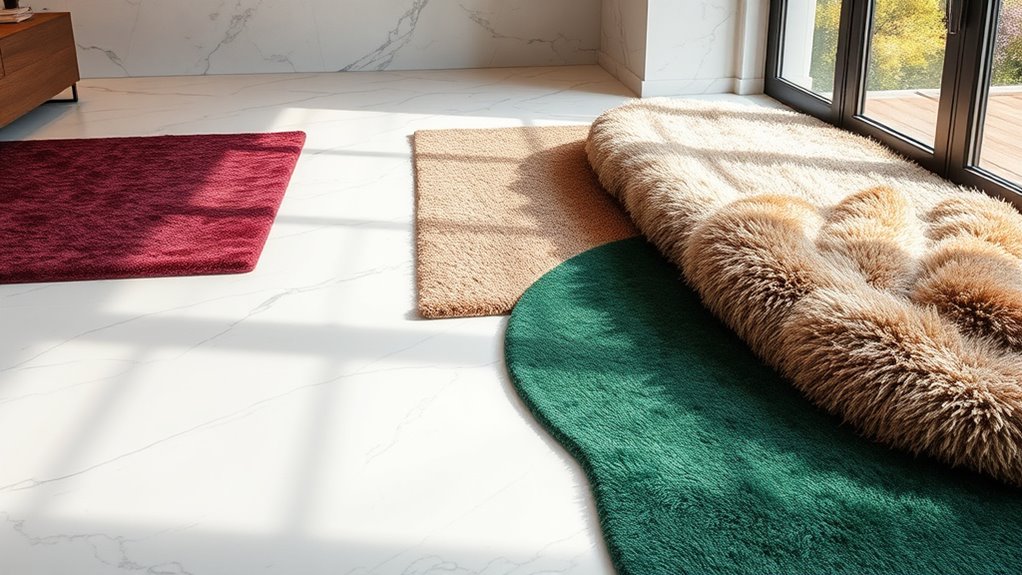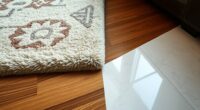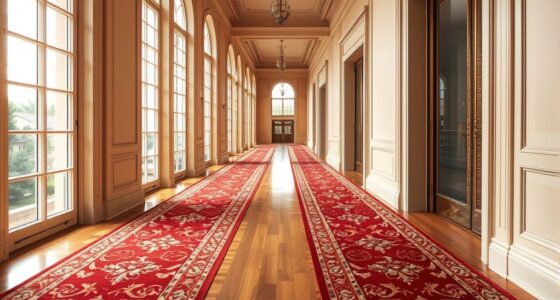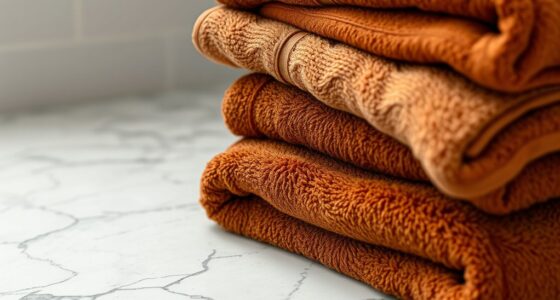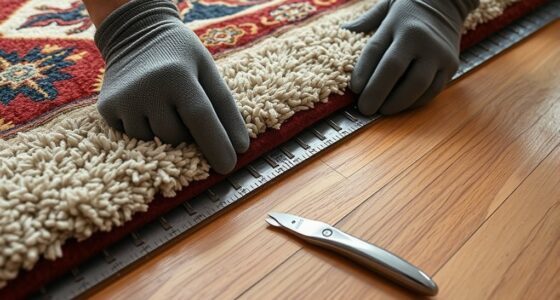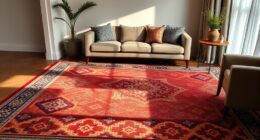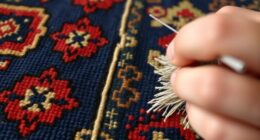To turn cold tiles into a cozy luxury, start with a durable base rug that complements your space and secure it with a non-slip pad. Layer textured and patterned mats for visual depth and safety, then add plush area rugs for warmth and softness. Use runners to define spaces and guarantee all rugs are securely anchored. For the best results and stylish cohesion, exploring further will reveal how to master these layering techniques seamlessly.
Key Takeaways
- Use large, plush area rugs with dense piles like wool or shag to add warmth and softness over cold tiles.
- Layer textured and patterned mats with anti-slip backing to enhance comfort, safety, and visual appeal.
- Incorporate smaller rugs or runners with cozy tones for seasonal warmth and inviting ambiance.
- Secure layered rugs with non-slip pads or double-sided tape to prevent bunching and ensure stability.
- Regularly maintain and coordinate rug colors and textures to create a cohesive, luxurious, and warm floor environment.
Choosing the Right Base Rugs for Hard Floors
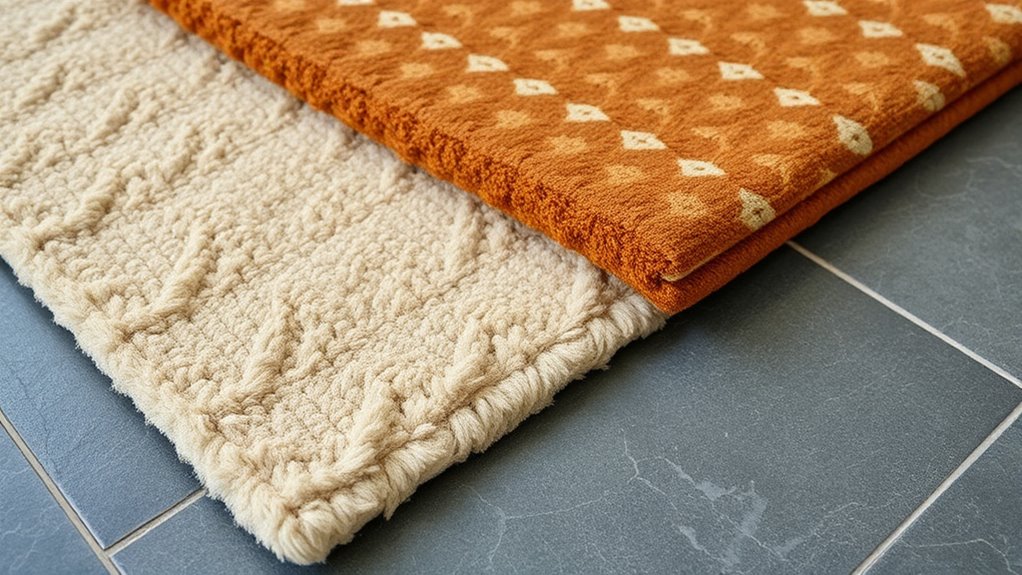
When selecting base rugs for hard floors, ensuring durability and slip resistance is essential. You want a rug made from sturdy area rug materials like wool, nylon, or polypropylene, which can withstand foot traffic without wearing down quickly. It’s also important to follow rug sizing guidelines; choose a size that complements your space without overwhelming it. For smaller rooms or entryways, opt for rugs that leave a border around the edges, while larger areas benefit from rugs that anchor the furniture. Keep in mind that a rug with a non-slip backing or adding a rug pad underneath enhances stability and prevents accidents. By prioritizing durable materials and proper sizing, you create a safe, stylish foundation perfect for layering with other textures and patterns. Additionally, selecting a rug with moisture resistance can help protect it from spills and humidity, prolonging its lifespan and maintaining its appearance. Incorporating suitable rug padding can further improve comfort and longevity, especially on hard surfaces. Being aware of potential environmental impacts when choosing materials can also contribute to a more sustainable home environment. Using eco-friendly options like natural fibers helps reduce the environmental footprint of your home decor choices.
Layering With Textured and Patterned Mats
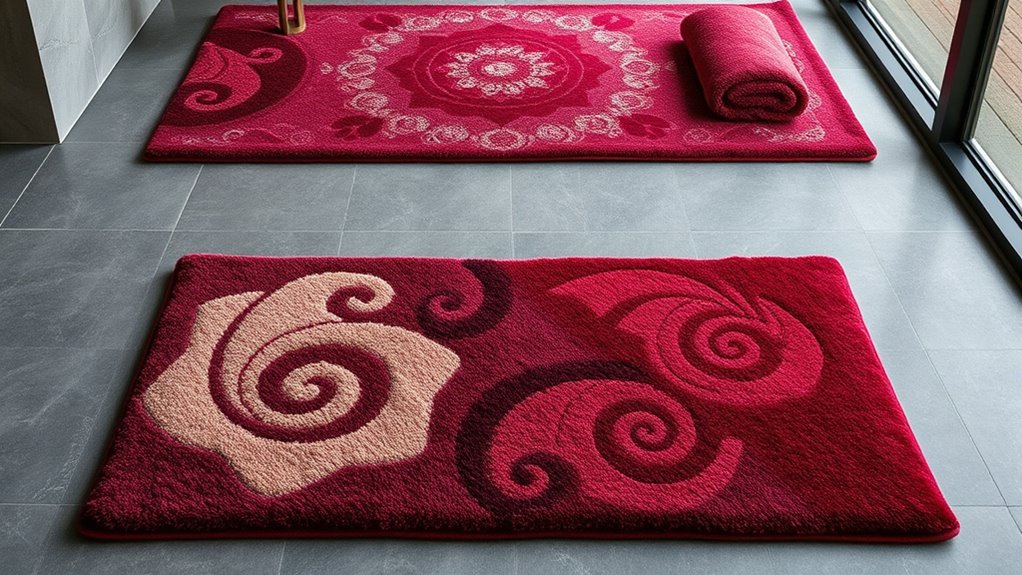
Adding textured and patterned mats instantly boosts visual depth in your space, making your floors more interesting. They also provide extra comfort underfoot, especially in high-traffic areas. Plus, their textured surfaces help improve safety by reducing slips and falls. Incorporating home organization principles can further enhance your space by creating a cohesive and functional environment. Additionally, selecting mats with non-slip surfaces can increase safety and stability on your hard floors. To maximize safety, consider mats that feature anti-slip backing for added grip and security.
Enhancing Visual Depth
Layering textured and patterned mats on hard floors instantly creates a sense of visual depth, making your space feel more dynamic and inviting. To enhance this effect, choose mats with contrasting colors to amplify color contrast and draw the eye. Play with shadow play by positioning mats where natural or artificial light creates interesting shadows, adding dimension to your flooring. Mix patterns and textures thoughtfully to avoid visual clutter while maintaining interest. For example, pair a muted, textured mat with a more vibrant patterned one to establish layers without overwhelming the space. This technique adds complexity and richness, making your floor look less flat and more engaging. Incorporating vintage decor elements such as antique rugs or distressed textiles can further deepen the textured layers and enhance the rustic charm. The strategic use of contrast and shadow ensures your layered mats contribute to a sophisticated, multi-dimensional aesthetic. Additionally, practicing mindful layering can help you balance visual interest with harmony, creating a cohesive and inviting environment. Understanding the importance of texture in design can guide you in selecting materials that add depth without overwhelming the overall look. Moreover, experimenting with different layering techniques can lead to unique and personalized floor arrangements that reflect your style.
Increasing Comfort and Safety
Have you considered how textured and patterned mats can boost both comfort and safety on hard floors? These mats serve as effective non-slip solutions, reducing the risk of slips and falls, especially in high-traffic areas or around moisture-prone zones. Their textured surfaces provide better grip, giving you stability underfoot. Additionally, patterned mats add visual cues that help prevent accidents by clearly marking walkways or hazard zones. When choosing mats, consider allergy considerations by selecting those made from hypoallergenic materials that trap dust and debris, helping to improve indoor air quality. Incorporating proper storage into your selection process can also reflect personal style and sensitivities, making your space both functional and expressive. Moreover, selecting mats with appropriate caffeine content can influence your mood and energy levels, contributing to a more comfortable environment. This is especially important as layering techniques with mats can help insulate your floors and add a cozy touch during colder months. Layering with these mats not only enhances comfort by softening hard surfaces but also creates a safer environment, giving you peace of mind whether you’re moving around or just relaxing at home.
Incorporating Warm and Plush Area Rugs

To create a cozy and inviting atmosphere on your hard floors, incorporating warm and plush area rugs can make a significant difference. Choosing the right area rug materials, like wool or shag, adds softness and insulation, making your space feel more comfortable. When applying rug layering techniques, start with a larger rug as a base, then add smaller, plush rugs on top to enhance warmth and texture. Opt for dense pile rugs that trap heat and provide plush cushioning underfoot. Active listening and color coordination can further enhance the harmony of your decor. Coordinating colors and patterns with your existing decor creates visual harmony while emphasizing comfort. Layering rugs not only elevates your room’s aesthetic but also transforms cold, hard surfaces into inviting, luxurious spaces. This simple upgrade makes your home feel warmer and more welcoming. Additionally, selecting high-quality rugs from trusted brands ensures durability and long-lasting comfort. Incorporating business insights can help you choose options that balance quality and cost-effectiveness, ensuring a smart investment in your home decor. Employing proper layering techniques also involves considering the insulation benefits of different rug materials to maximize warmth.
Using Runners to Define and Warm Up Spaces
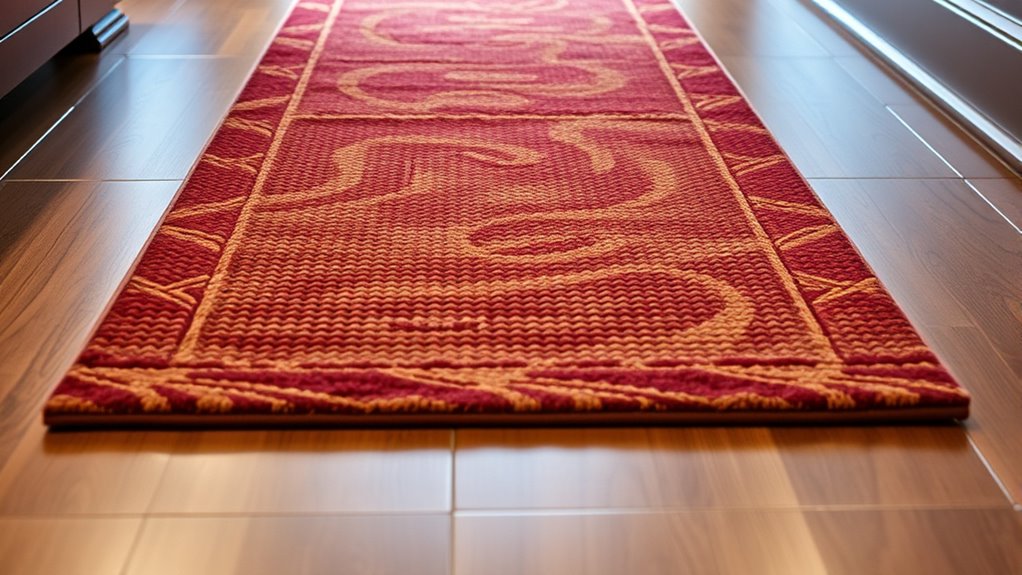
Runners are a practical and stylish way to define distinct areas within open floor plans or long hallways. They add visual boundaries without closing off space, making your home feel more organized. Choosing runners with decorative edging enhances their aesthetic appeal, giving a polished look that complements your decor. During colder months, a wool or thick fiber runner helps to warm up a space, while in warmer seasons, lighter fabrics can keep the area feeling fresh. Seasonal variations in runner styles and colors allow you to adjust the ambiance—bright patterns in summer or rich, cozy tones in winter. These versatile pieces not only provide warmth and structure but also add personality, making your spaces feel inviting and well-defined. Incorporating seasonal variations in your runner choices can also reflect your overall home decor theme and mood. Additionally, selecting runners made from quality materials ensures durability and long-lasting style. Using material qualities like softness and resilience can enhance comfort underfoot and maintain the runner’s appearance over time. Employing the right layering techniques with runners can further elevate your interior design and functionality.
Tips for Securing Rugs and Mats Safely
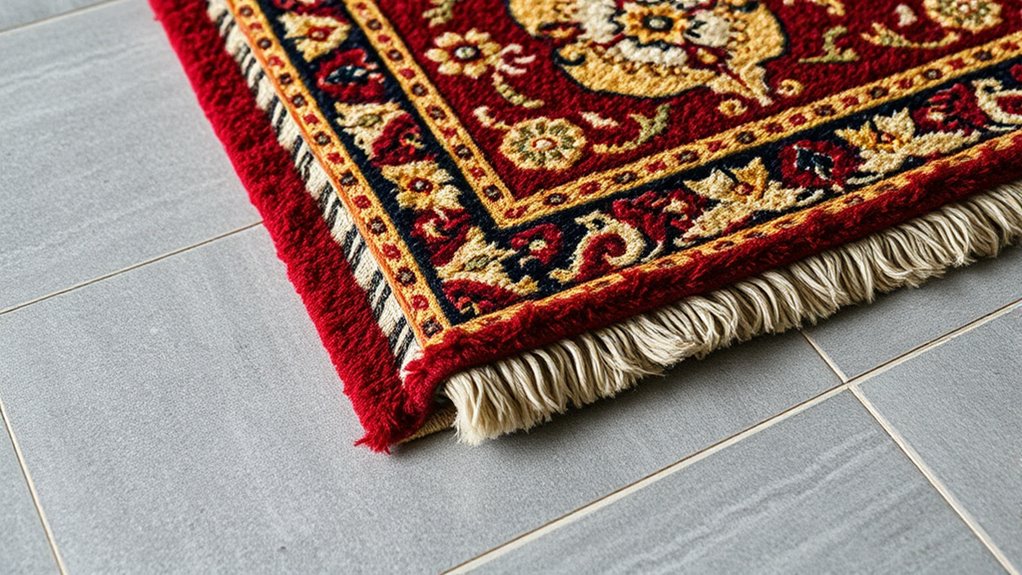
Securing rugs and mats properly is essential to prevent slips and accidents. Start with adhesive safety tips by choosing non-slip rug pads or double-sided tape designed for flooring types. These options provide reliable grip without damaging your surface. When using rug anchoring methods, ensure they are appropriate for your floor material—some adhesives may not suit hardwood or tile. Secure edges and corners to keep the rug flat and prevent bunching. Regularly check the rug’s stability and reapply adhesives or adjust anchoring as needed. Avoid using overly sticky tapes that could leave residue or damage the floor. Properly secured rugs not only enhance safety but also contribute to a polished look, making your space both stylish and secure.
Combining Colors and Materials for Visual Cohesion

Creating a cohesive look on your hard floors involves thoughtfully combining colors and materials to enhance the overall aesthetic. Focus on color palette coordination to ensure your choices complement each other, avoiding clashes. Use material mixing techniques like pairing smooth tiles with textured rugs to add depth and interest. Balance bold hues with neutral tones to create harmony and prevent visual overload. Here’s a simple guide:
| Color Palette | Material Type | Effect |
|---|---|---|
| Monochrome | Hardwood | Elegant, seamless |
| Contrasting | Metal accents | Modern, lively |
| Analogous | Stone and textiles | Cozy, warm |
Maintenance and Care for Layered Floor Coverings
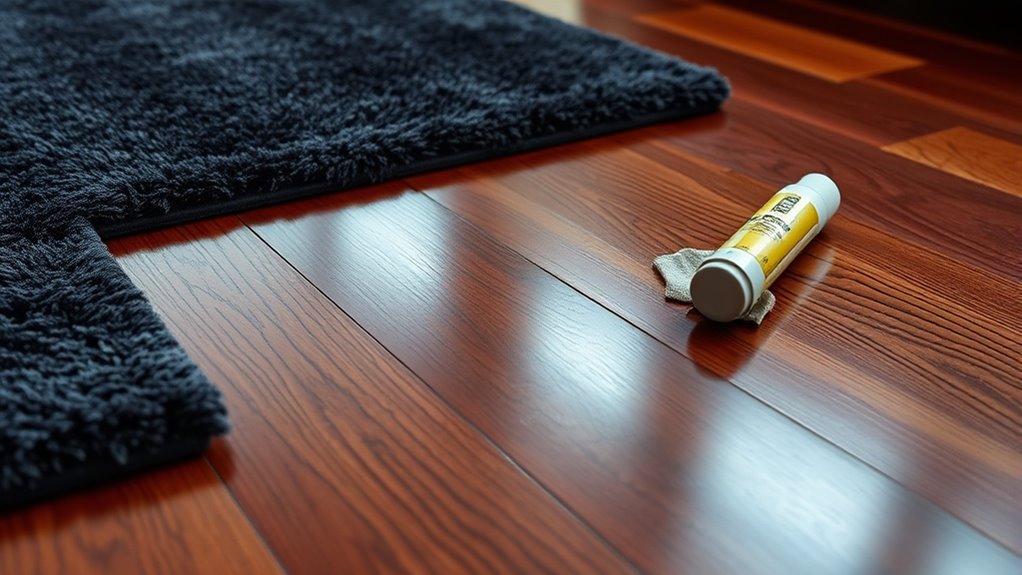
To keep layered floor coverings looking their best, regular maintenance is essential. Establish a consistent cleaning schedule to prevent dirt and debris from settling into the layers, which can cause damage over time. Use gentle cleaning methods suitable for your materials, like sweeping or vacuuming with a soft brush. To prevent stains, immediately clean spills and avoid harsh chemicals that could damage the surface. Place doormats at entry points to reduce dirt and moisture. Regularly inspect your layers for signs of wear or damage, addressing issues promptly. Protect high-traffic areas with rugs or additional padding. Stain prevention is key to maintaining the appearance and longevity of your layered floors, so stay vigilant and proactive with your care routine.
Frequently Asked Questions
How Can I Prevent Rugs From Slipping on Hard Floors?
To prevent rugs from slipping on hard floors, you should use non-slip pads or rug grippers. Place non-slip pads underneath your rug for a secure grip, especially on smooth surfaces like tiles or wood. Rug grippers are also effective—they anchor the rug in place and prevent any sliding. Make sure the pads or grippers are clean and fit well to keep your rug safe and stable, reducing the risk of accidents.
What Are Eco-Friendly Options for Layered Flooring?
You might find it rewarding to explore eco-friendly layering options for your floors. Consider sustainable materials like cork, bamboo, or reclaimed wood, which offer durability and style. Biodegradable options such as jute or natural fiber rugs also add warmth without harming the environment. These choices help create a luxurious space while staying kind to the planet, blending sophistication with eco-consciousness effortlessly.
How Do I Choose Rugs That Suit Different Room Functions?
When choosing rugs for different rooms, think about the room’s function and style coordination. For high-traffic areas, pick durable area rugs that resist wear. In cozy spaces, opt for plush, softer textures. Match colors and patterns to your existing decor to create harmony. Always measure your space accurately to guarantee the rug fits well, enhancing comfort and style while fulfilling the room’s purpose effectively.
Can Layering Rugs Improve Sound Insulation?
While it might seem like a small change, layering rugs can subtly boost soundproofing benefits and acoustic enhancement in your space. You’ll find that multiple rugs absorb sound waves more effectively, reducing echoes and noise transmission. This simple technique not only adds visual interest but also creates a quieter, more comfortable environment—making your rooms feel cozier and more inviting, all while enhancing overall sound insulation.
What Safety Considerations Are There When Layering Rugs?
When layering rugs, you should consider safety carefully. Make certain rugs have non-slip backing to prevent falls, especially on smooth surfaces. Be aware of fire hazards; avoid placing rugs near open flames or heat sources. Additionally, think about pest control—thick layers can trap dust and pests, so keep rugs clean and regularly inspected. These precautions help you enjoy layered rugs safely while maintaining a cozy, stylish space.
Conclusion
By layering rugs and mats thoughtfully, you turn cold, hard floors into cozy, inviting spaces. With the right combination of textures, colors, and secure placements, you add warmth and personality to your home. Isn’t it worth creating a space that feels both stylish and comfortable? So go ahead, experiment with layering, and enjoy the inviting atmosphere you’ve crafted—your feet—and your guests—will thank you.
